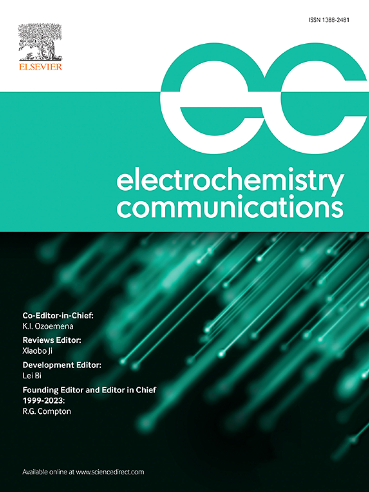pamam功能化NH2-MCM-41修饰玻碳电极溶出伏安法定量测定水样中的Cu (II
IF 4.2
3区 工程技术
Q2 ELECTROCHEMISTRY
引用次数: 0
摘要
铜离子是多种生理过程中必需的金属离子,但其过量积累会产生毒性,对人体健康和环境造成严重危害。因此,灵敏、准确地测定水样中铜的含量对公众健康保护和环境监测具有重要意义。本研究提出了一种基于pam -功能化nh2 -介孔二氧化硅(PAMAM-functionalized NH2-MCM-41)作为传感平台测定水样中Cu (II)离子的新策略。采用接枝法制备pamam功能化NH2-MCM-41。利用x射线衍射(XRD)、透射电子显微镜(TEM)和能谱分析(EDS)技术表征了pamam功能化的MCM-41的结构和形貌。然后,采用pamam功能化的NH2-MCM-41修饰玻碳电极(GCE)进行差分脉冲阳极溶出伏安法(DPASV)测定Cu (II)。由于PAMAM树状大分子末端氨基对金属离子(Cu (II))的高螯合能力与MCM-41的大表面积相结合,PAMAM/NH2-MCM-41/GCE对Cu (II)的测定具有优异的灵敏效果。考察了影响Cu (II)溶出电流响应的不同参数和条件,包括富集时间、富集电位和pH值。在最优条件下,Cu (II)的溶出峰电流在0.002 μM ~ 8.0 μM之间随Cu (II)浓度的增加而线性增加。计算出Cu (II) (S/N = 3)的检出限(LOD)为6.1 × 10−10 M。最后,PAMAM/NH2-MCM-41/GCE传感器成功用于水样中Cu (II)的测定,可接受回收率为97.1% ~ 103.3%。结果表明,pamam功能化的MCM-41作为一种很有前途的改性材料,可用于设计和制造重金属离子测定电化学传感器。本文章由计算机程序翻译,如有差异,请以英文原文为准。
Application of PAMAM-functionalized NH2-MCM-41 modified glassy carbon electrode for quantitative determination of Cu (II) in water samples by using stripping voltammetry
Copper ions act as essential metal ions in various physiological processes, but their excessive accumulation can cause toxicity and severe risks to human health and the environment. Hence, the sensitive and accurate determination of copper levels in water samples is of great significance for public health protection and environmental monitoring. In this study, a new strategy was proposed for the determination of Cu (II) ions in the water samples based on polyamidoamine dendrimer-functionalized NH2-mesoporous silica (PAMAM-functionalized NH2-MCM-41) as a sensing platform. The PAMAM-functionalized NH2-MCM-41 was prepared by using a post-grafting method. The structure/morphology of the prepared PAMAM-functionalized MCM-41 was characterized by X-ray diffraction (XRD), transmission electron microscopy (TEM), and energy-dispersive X-ray (EDS) spectroscopy techniques. Then, the PAMAM-functionalized NH2-MCM-41 modified glassy carbon electrode (GCE) was used for differential pulse anodic stripping voltammetric (DPASV) determination of Cu (II). Due to the combination of the high chelating ability of terminal amino groups of PAMAM dendrimer to metal ion (Cu (II)) with the large surface area of MCM-41, the PAMAM/NH2-MCM-41/GCE showed an excellent sensitive effect for Cu (II) determination. The different parameters and conditions affecting the stripping current response of Cu (II), including accumulation time, accumulation potential, and pH value were investigated and optimized. Under the optimum conditions, the stripping peak current of Cu (II) linearly increased with its concentration between the 0.002 μM–8.0 μM. The limit of detection (LOD) is calculated to be 6.1 × 10−10 M for Cu (II) (S/N = 3). Finally, the PAMAM/NH2-MCM-41/GCE sensor was successfully used for the Cu (II) determination in water samples, with acceptable recoveries of 97.1 %–103.3 %. The obtained results showed that PAMAM-Functionalized MCM-41 as a promising modifying material can be potentially used in the design and fabrication of electrochemical sensors for heavy metal ions determination.
求助全文
通过发布文献求助,成功后即可免费获取论文全文。
去求助
来源期刊

Electrochemistry Communications
工程技术-电化学
CiteScore
8.50
自引率
3.70%
发文量
160
审稿时长
1.2 months
期刊介绍:
Electrochemistry Communications is an open access journal providing fast dissemination of short communications, full communications and mini reviews covering the whole field of electrochemistry which merit urgent publication. Short communications are limited to a maximum of 20,000 characters (including spaces) while full communications and mini reviews are limited to 25,000 characters (including spaces). Supplementary information is permitted for full communications and mini reviews but not for short communications. We aim to be the fastest journal in electrochemistry for these types of papers.
 求助内容:
求助内容: 应助结果提醒方式:
应助结果提醒方式:


